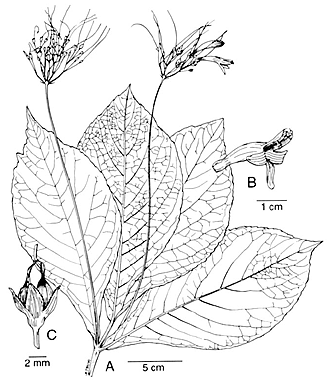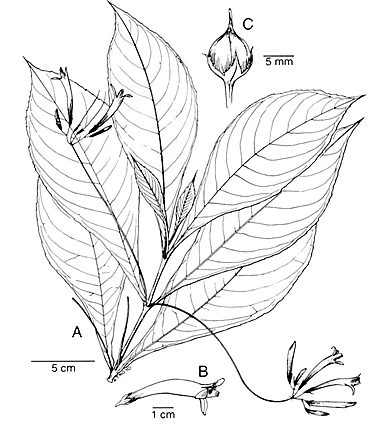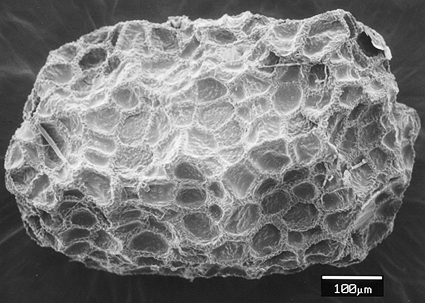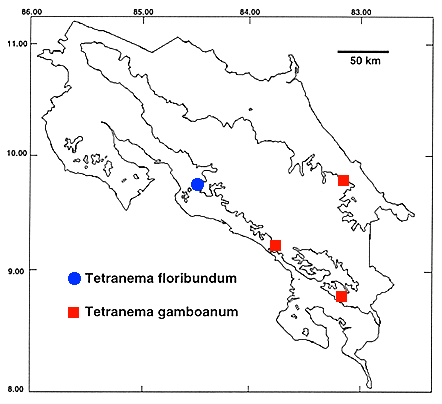 |
QUICK SEARCH
MO PROJECTS:
Africa
Asia/Pacific
Mesoamerica
North America
South America
General Taxonomy
Photo Essays
Training in Latin
America
MO RESEARCH:
Wm. L. Brown Center
Bryology
GIS
Graduate Studies
Research Experiences
for Undergraduates
Imaging Lab
Library
MBG Press
Publications
Climate Change
Catalog Fossil Plants
MO DATABASES:
W³MOST
Image Index
Rare Books
Angiosperm
Phylogeny
Res Botanica
All Databases
INFORMATION:
What's New?
People at MO
Visitor's Guide
Herbarium
Jobs & Fellowships
Symposium
Research Links
Site Map
Search
The genus Tetranema (Scrophulariaceae) in Costa Rica with two new speciesMichael H. Grayum and Barry E. Hammel
In preparation for the Manual to the Plants of Costa Rica, this paper was reviewed and mailed to Phytologia on 16 Feb. 1996. It was made available on two Web sites (INBio and MO) by 4 March 1996 and revised on 15 March 1996. Abstract. Two new species of Tetranema (Scrophulariaceae) are described from Costa Rica: T. gamboanum Grayum & Hammel, known from wet forests on both slopes, and T. floribundum Hammel & Grayum, endemic to Cerro Turrubares in the mid-Pacific region. Both are unusual in having a long-stemmed growth habit and red, tubular corollas presumably adapted for pollination by hummingbirds. The new species are most similar, at least in floral morphology, to the Mexican endemic, T. megaphyllum (Brandegee) L. O. Williams. These are the first records of the genus from south of Honduras, and increase the total number of species in the genus from four to six. Key Words: Costa Rica, Scrophulariaceae, Tetranema A wealth of botanical material gathered during the exploration of a remote region on the Atlantic slope of Costa Rica's Cordillera de Talamanca in April, 1989, included one particularly remarkable collection made by Costa Rican botanist Gerardo Herrera. This collection was remarkable in representing a conspicuous, terrestrial herb--an asterid dicot with bright red, tubular corollas ca. 5 cm long--that we were unable to identify, even to the generic level. Though its flowers superficially resembled those of some Acanthaceae known from the region [Odontonema tubaeforme (Bertol.) Kuntze, Razisea spicata Oerst.], the Herrera collection was eventually identified as belonging to Scrophulariaceae. However, the combination of a caulescent, subshrubby growth habit and axillary, long-pedunculate, bracteolate, cymose inflorescences seemed incompatible with any known genus; indeed, we entertained the notion of establishing a new genus to accommodate this collection and other, similar material that has subsequently emerged from Costa Rica. With respect to their shrublike habit, axillary, cymose inflorescences and red, tubular corollas, the above-mentioned Costa Rican collections suggest the genus Russelia Jacq., of the monotypic tribe Russeliae. Russelia differs, however, in having septicidal capsules densely packed with hairs. The Costa Rican material better concords with tribe Cheloneae sensu Thieret (1954), characterized by bracteolate, cymose or racemose inflorescences and sterile posterior stamen filaments. The only members of this group occurring naturally in the Mesoamerican region are the large genus Penstemon Schmidel and the oligotypic Tetranema Benth. ex Lindl. and Uroskinnera Lindl. (though none of these has been recorded from south of Honduras). Each of these three genera includes at least one species with red, tubular, resumably hummingbird-pollinated flowers (see, e.g., Daniel & Breedlove, 1992). Tetranema differs from Penstemon and Uroskinnera in having axillary and cymose (rather than terminal and racemose or thrysoid) inflorescences and much reduced sterile stamens (staminodes); it further differs from Uroskinnera in having distinct sepals, and from Penstemon in having loculicidal capsules. In all of these critical details, the Costa Rican material accords perfectly with Tetranema. Moreover, the seeds of the one Costa Rican collection examined in this regard (Fig. 2) are a very convincing match for those of Tetranema roseum (M. Martens & Galeotti) Standl. & Steyerm. as illustrated by Beaufort-Murphy (1983: Pl. 4G) (who, unfortunately, did not study Uroskinnera or Penstemon). Our initial attempts to identify the Costa Rican material to the genus level were thwarted by our reliance on Standley & Williams's (1973) Flora of Guatemala Scrophulariaceae treatment. In their generic key (p. 321), the leads are inverted in the couplet purporting to separate Tetranema from Uroskinnera and Penstemon (as pointed out by Daniel & Breedlove, 1992). Furthermore, the three Tetranema species occurring in Guatemala are all quite unlike the Costa Rican material in being acaulescent or short-stemmed herbs with campanulate, white or purple (fide Standley and Williams) corollas. Tetranema has heretofore been considered a genus of four species ranging from southern Mexico (Puebla) to Honduras (Méndez-Larios & Villaseñor, 1955). Tetranema roseum, the most wide-ranging species, is of modest horticultural repute as a glasshouse plant, with at least two cultivars available commercially under the name "Mexican foxglove" (Morrison, 1981). The Costa Rican material of Tetranema is here treated as comprising two species new to science, bringing the generic total to six. Tetranema gamboanum Grayum and Hammel is represented by the Herrera collection from the Atlantic slope and several subsequent collections from wet-forest sites on the Pacific slope, while T. floribundum Hammel and Grayum is known only by three collections from Cerro Turrubares, an isolated peak in the central Pacific region. Tetranema gamboanum Grayum & Hammel, sp. nov. TYPE: COSTA RICA. Puntarenas: Cantón de Osa, Fila Costeña, cabeceras del Río Piedras Blancas, Cerro Anguciana, 8°49'12"N, 83°11'15"W, 900 m, 7 Dec 1993 (fl., fr.), Aguilar et al. 2700 (HOLOTYPE: INB!; Isotypes BM!, CAS!, CR!, F!, MEXU!, MO!, NY!, US!). Figures 1-2. Species cum Tetranemate megaphyllo optime congruens sed differt foliis apice longiacuminatis bracteis inflorescentia brevioribus corolla longiore lobis corollae multo longioribus.
Figure 1. Tetranema gamboanum. A. flowering shoot; B. corolla; C. fruit. (A, B from Aguilar et al. 2700; C from Hammel 19429). Erect, decumbent-based herbs 12+ m tall. Internodes to at least 11 cm long, strigulose when young. Petioles obsolete to ca. 1 cm long. strigulose, canaliculate above, the margins ciliate proximally, the hairs extending in a line across the node. Leaves 1431 X 511 cm, elliptical to oblanceolate or spatulate, long-acuminate at apex, attenuate to the base (where decurrent onto the petiole), the margins ± coarsely serrate, glabrous above or with few, distant hairs along the midrib and major veins (especially proximally), pubescent along the veins below, midrib often falcate, primary lateral veins ca. 913 per side, prominulous on both sides when dry. Inflorescences axillary, cymose; peduncle 924 cm long, divergent, green, quadrangular with the angles narrowly winged. Flowers ca. 212 per inflorescence, bracteate, the bracts 0.52 mm long, subulate to narrowly triangular, ciliate on margins; pedicels ca. 911 mm long at anthesis, to ca. 20 mm in fruit, glabrous; calyx 5-merous, divided nearly to base, the lobes ca. 35 mm long at anthesis (to ca. 6 mm in fruit), ± narrowly to broadly ovate, imbricate, ± cornute apically, ciliate on margins; corolla ca. 4.95.5 cm long, scarlet, tubular, slightly curved (convexly) upward and gradually expanded distally, glabrous throughout or Herrera & Chacón 2644) with flat hairs at the mouth and onto the lower lobes, the lobes 4, 1113 X 33.5 mm, imbricate, lanceolate, the 3 lower ones obtuse to rounded apically and spreading-reflexed, the upper one emarginate and slightly wider; fertile stamens 4, exserted from the throat (but not exceeding the upper corolla lobe); filaments attached at base of corolla tube, glabrous, ± dilated toward base; anther sacs 0.81.0 mm long, confluent apically and becoming divergent, glabrous; staminode ca.1.52.0 mm long; ovary 34 mm long, narrowly ovoid, glabrous; style exserted, glabrous; stigma clavate to funnelform, hollow, the rim papillose; fruit a loculicidal capsule, ca. 69 mm long, subglobose-apiculate; seeds ca. 0.60.7 X 0.45 mm, oblong, amber to black, densely foveolate. Additional specimens examined. COSTA RICA. Limón: Cordillera de Talamanca, entre Cerro Muchilla y Cerro Avioneta, cabeceras de Río Suruy, Fila Matama, 9°47'25"N, 83°06'30"W, 550 m, 17 Apr 1989 (fl.), Herrera & Chacón 2644 (BM, CR, INB, MEXU, MO, USJ). Puntarenas: Cantón de Osa, upper headwaters of Río Piedras Blancas, W slopes of Cerro Anguciana, Fila Cruces, 8°49'12"N, 83°11'09"W, 9501150 m, 10 Dec 1993 (fl.), Grayum 10663 (CAS, BM, CR, F, INB, MEXU, MO); same locality, 7 Dec 1993 (fl., fr.), Hammel et al. 19200 (CR, INB, F, MO). San José: Cantón de Pérez Zeledón, Fila Costeña, Fila Tinamastes, por la carretera entre Dominical y San Isidro, 9°18'43"N, 83°46'19"W, 950 m, 3 Feb 1994 (fl., fr.), Hammel et al. 19429 (COL, CR, INB, MICH, MO, TEX); same locality, 28 Mar 1994 (fl., fr.), Hammel et al. 19542 (CR, INB, MO; live at MO).
Fig. 2. Tetranema gamboanum (Hammel et al. 19542); seed; X 150 (photo by Betty Strack). Tetranema gamboanum is endemic to Costa Rica, where it is known by a single collection from the Atlantic slope of the Cordillera de Talamanca (Fila de Matama) at 550 m elevation, and from two, widely separated sites in the Pacific Fila Costeña at ca. 900-1000 m (Fig. 3). All of these stations appear to lie in the Premontane Rain Forest Life Zone of the Holdridge system (cf. Tosi, 1969). Flowering material of T. gamboanum has been collected from December through April.
Fig. 3. Distribution of Tetranema in Costa Rica (500 m contour is indicated). As mentioned previously, Costa Rican material of Tetranema does not concord well with any of the three species treated in the Flora of Guatemala (Standley & Williams, 1973). It does, however, compare reasonably well with the Mexican T. megaphyllum Brandegee) L. O. Williams, at least in terms of gross floral morphology. The original description of Allophyton megaphyllum Brandegee (1914) specified tubular, red corollas ("Corollae tubus cylindraceus...Corollae coccineae") that "resemble those of Russelia," and subsequent descriptions agree on this point. This is the only Tetranema species from north of Costa Rica that has tubular corollas, though those of T. evolutum Donn. Sm. may be red (fide Méndez-Larios & Villaseñor, 1995; Standley and Williams described them as "bright purple"). Tetranema gamboanum would seem to differ from T. megaphyllum in comprising taller (12+ m), coarser plants. Although the specimens studied by Brandegee (1914) were "not complete enough to give the size of the plant," the leaves were said to be "crowded," suggesting that the plants may have been short-stemmed. Pennell (1925), the first to ally the "most remarkable" Allophyton megaphyllum with Tetranema (using the name Allophyton Brandegee for the entire group), stated that "all the species of Allophyton have short stems," more specifically, "1 dm long or less." Pennell cited three duplicates of a topotype collection (Purpus 7921) not cited by Brandegee. Mendéz-Larios & Villaseñor (1995), citing three additional collections not seen by previous authors, characterize T. megaphyllum as "la especie con desarrollo vegetativo más vigoroso;" nevertheless, they describe it as having "tallos muy reducidos," 2540 cm tall. Although we have been unable to obtain the holotype of Tetranema megaphyllum on loan, we have studied an isotype (Purpus 6855, NY), as well as the NY duplicate of the topotype cited by Pennell (1925). While neither of these specimens bears label data indicating either the habit of the plants or the color of the corollas, the following differences from T. gamboanum are manifest: T. megaphyllum has inflorescence bracts to ca. 10 mm long and corollas ca. 2.53.6 cm long with rounded, apparently forward-directed lobes ca. 24 mm long; T. gamboanum, on the other hand, has inflorescence bracts to ca. 2 mm long and corollas ca. 5 cm or more long with elongate, spreading-reflexed lobes ca. 1113 mm long. These observations are corroborated by Méndez-Larios & Villaseñor's (1995) description of T. megaphylllum. The occurrence of Tetranema gamboanum on both the Atlantic and Pacific slopes has innumerable precedents in the Costa Rican flora. The lone collection from the Atlantic slope (Herrera & Chacón 2644) is essentially a perfect match for the Pacific material, except for the unusual corolla hairs noted in the description. Whether these hairs are characteristic of Atlantic populations, and thus potentially indicative of infraspecific rank, cannot be decided without additional material. Tetranema gamboanum is probably more widespread in Costa Rica than our scattered records indicate; it may also yet be found in Panama. Although it is locally more or less abundant, none of the three known stations lies within a protected area. This appears to be a species of relatively undisturbed habitats. We take great pleasure in dedicating this new species to William Gamboa Elizondo (1958 ) of Las Mellizas de Coto Brus, Costa Rica, who has participated enthusiastically in virtually every major botanical expedition into the Cordillera de Talamanca since 1983 as cook, porter, scout, negotiator, and occasional collector. Tetranema floribundum Hammel & Grayum, sp. nov. TYPE: COSTA RICA. San José: Cantón de Turrubares, lado N de Cerro Turrubares, al S de San Rafael por Quebrada Pital, 9°48'05"N, 84°27'52"W, 1,200-1,300 m, 5 Jan 1996 (fl., fr.), Hammel, Jiménez & Morales 20068 (HOLOTYPE: INB!; Isotypes: BM!, CR!, F!, MO!). Figure 4. Species ex affinitate Tetranematis megaphylli et T. gamboani, ab utroque inflorescentiis omnibus (8) 1430-floris, tubo corollae intus ventraliter in longitudinem pubescenti distincta.  Fig. 4. Tetranema floribundum. A. flowering shoot; B. corolla; C. fruit. (A, C from Jiménez et al. 1155; B from Hammel et al. 20068). Erect, decumbent-based herbs (0.35) 0.802 m tall, often rooting at decumbent nodes. Internodes to at least 15 cm long, densely matted-, arachnoid- or woolly-pubescent when young. Petioles essentially obsolete, the often undulate margin of the leaf blade reaching nearly to the node. Leaves 2123.5 X 913 cm, broadly elliptic to oblanceolate or spatulate, rounded, abruptly acute or short-acuminate at apex, acute to mostly concavely and abruptly attenuate to the base, the margins coarsely serrate to undulate-toothed, glabrous above except on the midrib at the very base, strigulose on the midrib and main veins below and minutely scaly (and thus shiny, when dry) throughout the abaxial leaf surface, midrib occasionally falcate, primary lateral veins 810 (11) per side, prominent below. Inflorescences axillary, cymose; peduncle 1323 cm long, purple, quadrangular with the angles narrowly winged. Flowers ca. (8) 1430 per inflorescence, bracteate, the bracts narrowly triangular 15 mm, ciliate (often only at base) on margin; pedicels ca. 10 mm long at anthesis, to ca. 20 mm in fruit, glabrous; calyx 5-merous, divided nearly to base, the lobes 23 mm long at anthesis (to 4 mm in fruit), broadly ovate, ± cornute apically, ciliate on margins; corolla 2.63.5 cm long, red, tubular, gradually slightly curved (convexly) upward and expanded distally, glabrous externally, internally pubescent with a narrow band of flat, yellow hairs (to ca. 1 mm long) on the ventral surface of the tube from near the base to the mouth and often all along the median lower lobe, the lobes 4, ca. 13 X 2.55.5 mm, ± lanceolate, the 3 lower ones rounded apically and spreading-reflexed, the upper one emarginate and slightly wider; fertile stamens 4, exserted from the throat (but held just below the upper corolla lobe and usually not exceeding it); the filaments attached at the base of the corolla tube, anther sacs 0.80.9 mm long, confluent apically (where attached to the filament), divergent at dehiscence (full length) and then broadly elliptic, glabrous; staminode ca. 0.5 mm long; ovary ca. 3.5 mm long, narrowly ovoid, glabrous; style exserted (with the stamens), glabrous, stigma clavate, hollow; fruit to ca. 8 mm (immature), ovoid. Additional specimens examined. COSTA RICA. San José: Z. P. Cerros de Turrubares, sector San Rafael, Potenciana arriba, cerca del Cerro Turrubares, 9°48'00"N, 84°27'10"W, 1,600 m, 4 Mar 1993 (fl., fr.), Jiménez, Quesada & Ramírez 1155 (BM, CR, INB, MEXU, MO); Sitio Cerro Pelón, 09°49'00"N, 84°28'50"W, 1,200 m, 6 Dec. 1991 (fl.), Zúñiga 599 (INB). Tetranema floribundum is endemic to Costa Rica, where it is known only from Cerro Turrubares, an isolated peak in the central Pacific region, at 1200-1600 m elevation (Fig. 3). This region apparently corresponds to the Lower Montane Rain Forest Life Zone of the Holdridge system (cf. Tosi, 1969). The three flowering collections of T. floribundum are from December, January, and March. The specific epithet of Tetranema floribundum reflects the fact that it has more flowers (ca. 1430) per inflorescence, on average, than any other known Tetranema species (T. roseum may have as many as 20). It differs additionally from T. gamboanum and T. megaphyllum, the only other species with red, tubular corollas, in having the corolla tube internally pubescent along the ventral surface. The corollar pubescence of the sole Atlantic slope collection of T. gamboanum, discussed previously, does not extend into the tube. Tetranema floribundum is further distinguished from T. gamboanum in having (as T. megaphyllum) merely acute to short-acuminate (rather than long-acuminate) leaf apices and smaller corollas, and from T. megaphyllum in having (as T. gamboanum) longer stems and generally larger corollas with relatively and absolutely much longer, spreading-reflexed lobes. It may seem unusual that Tetranema populations on Cerro Turrubares, in the central Pacific region of Costa Rica, should differ specifically from populations in the southern Pacific region, while the latter populations should be conspecific with material from the Atlantic slope (as discussed under T. gamboanum). Cerro Turrubares, however, is relatively high and quite isolated, and is known to harbor other endemic plant species (cf. Burger & Jiménez, 1994). Tetranema floribundum occurs at slightly higher elevations and, ostensibly, in a different life zone than T. gamboanum. Tetranema floribundum should presently be considered an endangered species, since it is known from just a few populations in a site that has already been serioulsy degraded by human activity. Two of the three collections were made within a protected area (Zona Protectora Cerro de Turrubares), but from a region dominated by pastures. Both of the new Costa Rican Tetranema species described herein will come out to T. megaphyllum in the key of Méndez-Larios & Villaseñor (1995). The distinguishing characteristics of these three species may be summarized as follows:
The recent discovery of Tetranema in Costa Rica is surprising, especially since both species comprise shrubby, understory plants with large, vividly scarlet corollas. Though the distribution of the genus in Costa Rica appears spotty, T. gamboanum, at least, may be locally abundant. At the Tinamastes site, a sizeable population occurs right at the roadside along a moderately well-botanized route (San Isidro de El General to Dominical). It is likely that earlier Costa Rican collections of Tetranema, not seen by us, will yet be discovered filed as undetermined, or misdetermined, in some of the many scattered herbaria housing Costa Rican material. As in the case of Ticodendron (Ticodendraceae), another conspicuous Central American plant described only recently, the belated recognition of Tetranema in Costa Rica is "perhaps explainable by the fact that although it looks very much like something well known [e.g., an Acanthaceae, Scutellaria, or Russelia], it really is something different" (Hammel & Burger, 1991: 92). Acknowledgements. The manuscript was critically reviewed by Thomas B. Croat and Gordon McPherson. We are also grateful to Silvia Troyo for the excellent line drawings; to William C. Burger and Betty Strack for arranging and executing (respectively) the SEM micrograph (Fig. 2); to Jacqueline Kallunki for expediting the delivery of important specimens from NY; to Quírico Jiménez for leading the second author to the type locality of Tetranema floribundum; and to Werner Bohl for initial help with HTML format. Field work was supported by National Geographic Society grants 3317-86 and 4682-91 to the first author. Publication was supported by National Science Foundation grant DEB-9300814 to both authors. Beaufort-Murphy, H. T. 1983. The seed surface morphology of the Gesneriaceae utilizing the scanning electron microscope and a new system for diagnosing seed morphology. Selbyana 6: 220422. Brandegee, T. S. 1914. Plantae mexicanae purpusianae, VI. Univ. Calif. Publ. Bot. 6: 5177. Burger, W. & Q. Jiménez. 1994. A new species of Psychotria subgenus Psychotria (Rubiaceae) from Costa Rica. Novon 4: 206208. Daniel, T. F. & D. E. Breedlove. 1992. A new species of Uroskinnera (Scrophulariaceae) from southern Mexico. Mandroño 39: 131136. Hammel, B. & W. C. Burger. 1991. Neither oak nor alder, but nearly: the history of Ticodendraceae. Ann. Missouri Bot. Gard. 78: 8995. Méndez-Larios, I. & J. L. Villaseñor. 1995. Revisión taxonómica del género Tetranema (Scrophulariaceae). Acta Bot. Mex. 32: 5368. Morrison, P. 1981. Tetranema roseum (Mexican Foxglove) formerly Allophyton mexicanum. Light Gard. 18: 180181. Pennell, F. W. 1925. The genus Allophyton of southern Mexico and Guatemala. Proc. Acad. Nat. Sci. Philadelphia 77: 269272. Standley, P. C. & L. O. Williams. 1973. Scrophulariaceae. In, P. C. Standley, L. O. Williams & D. N. Gibson (editors) Flora of Guatemala. Fieldiana, Bot. 24 (9): 319416. Thieret, J. W. 1954. The tribes and genera of Central American Scrophulariaceae. Ceiba 4: 164184. Tosi, J. A., Jr. 1969. Mapa ecológico, República de Costa Rica: Según la classificación de zonas de vida del mundo de L. R. Holdridge. San José: Centro Científico Tropical.
|
© 1995-2025 Missouri Botanical Garden, All Rights Reserved
4344 Shaw Blvd.
St. Louis, MO 63110
(314) 577-5100
Technical Support


